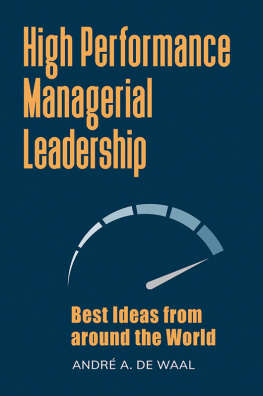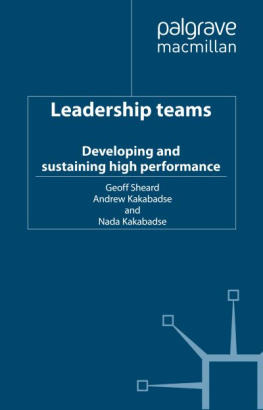André A. de Waal - High Performance Managerial Leadership
Here you can read online André A. de Waal - High Performance Managerial Leadership full text of the book (entire story) in english for free. Download pdf and epub, get meaning, cover and reviews about this ebook. year: 2020, publisher: ABC-CLIO, genre: Business. Description of the work, (preface) as well as reviews are available. Best literature library LitArk.com created for fans of good reading and offers a wide selection of genres:
Romance novel
Science fiction
Adventure
Detective
Science
History
Home and family
Prose
Art
Politics
Computer
Non-fiction
Religion
Business
Children
Humor
Choose a favorite category and find really read worthwhile books. Enjoy immersion in the world of imagination, feel the emotions of the characters or learn something new for yourself, make an fascinating discovery.
- Book:High Performance Managerial Leadership
- Author:
- Publisher:ABC-CLIO
- Genre:
- Year:2020
- Rating:4 / 5
- Favourites:Add to favourites
- Your mark:
- 80
- 1
- 2
- 3
- 4
- 5
High Performance Managerial Leadership: summary, description and annotation
We offer to read an annotation, description, summary or preface (depends on what the author of the book "High Performance Managerial Leadership" wrote himself). If you haven't found the necessary information about the book — write in the comments, we will try to find it.
High Performance Managerial Leadership — read online for free the complete book (whole text) full work
Below is the text of the book, divided by pages. System saving the place of the last page read, allows you to conveniently read the book "High Performance Managerial Leadership" online for free, without having to search again every time where you left off. Put a bookmark, and you can go to the page where you finished reading at any time.
Font size:
Interval:
Bookmark:

High Performance
Managerial Leadership
High Performance
Managerial Leadership
BEST IDEAS FROM AROUND THE WORLD
Andr A. de Waal
Foreword by Chris Abbott

Copyright 2020 by Andr A. de Waal
All rights reserved. No part of this publication may be reproduced, stored in a retrieval system, or transmitted, in any form or by any means, electronic, mechanical, photocopying, recording, or otherwise, except for the inclusion of brief quotations in a review, without prior permission in writing from the publisher.
Library of Congress Cataloging in Publication Control Number: 2019058323
ISBN: 978-1-4408-7264-8 (print)
978-1-4408-7265-5 (ebook)
24 23 22 21 201 2 3 4 5
This book is also available as an eBook.
Praeger
An Imprint of ABC-CLIO, LLC
ABC-CLIO, LLC
147 Castilian Drive
Santa Barbara, California 93117
www.abc-clio.com
This book is printed on acid-free paper 
Manufactured in the United States of America
Portions of this book have been adapted, with permission, from:
de Waal, A. A. (2017). Evaluating High Performance the Evidence-Based Way: The Case of the Swagelok Transformers, SAGE Open, OctoberDecember, pp. 115.
de Waal, A. A. (2018). Achieving High Performance at Zambias Competition and Consumer Protection Commission, Global Business and Organisational Excellence, Vol. 37, No. 4, pp. 1426.
de Waal, A. A., and Goedegebuure, R. (2017). Investigating the Causal Link between a Management Improvement Technique and Organizational Performance: The Case of the HPO Framework, Management Research Review, Vol. 40, No. 4, pp. 429450.
de Waal, A. A., and Hanna, D. (2016). HPO Model + HPO Framework = Organizational Improvement for a European Multinational, Global Business and Organizational Excellence, Vol. 35, No. 5, pp. 3043.
de Waal, A. A., and Heijtel, I. (2016). Searching for Effective Change Interventions for the Transformation into a High Performance Organization, Management Research Review, Vol. 39, No. 9, pp. 10801104.
de Waal, A. A., and Mulimbika, T. (2017). A Comparative Analysis of Zambian Governmental Institutions Using the HPO Framework, SAGE Open, JulySeptember, pp. 117.
de Waal, A. A., and Oudshoorn, M. (2015). Two Profiles of the Dutch High Performing Employee, European Journal of Training and Development, Vol. 39, No. 7, pp. 570585.
de Waal, A. A., and van der Heijden, B. I. J. M. (2015). The Role of Performance Management in Creating and Maintaining a High-Performance Organization, Journal of Organizational Design, Vol. 4, No. 1, pp. 111.
Contents
I first experienced the benefits of adopting the high performance organization (HPO) framework during my time in ATLAS, first as its chief operating officer (COO) and subsequently as the chief executive officer (CEO) of the consortium. The ATLAS HPO journey is well documented in Andrs book What Makes a High Performance Organization, and it is also referred to in this book. In summary, ATLAS was a consortium of technology companies serving defense and security customers. The consortium had struggled to form a team ethos across parent company boundaries, and the resultant siloed organization was suffering from change fatigue. This change was desperately needed but was rarely seen through to its conclusion, and many new changes were initiated before related changes were completed.
The consortium lacked a framework with a common language that would unify the teams toward better outcomes. HPO became that framework and was the missing ingredient that enabled the consortium to turn around its performance and move toward HPO status. Nearly ten years later, I was privileged to be offered an exciting opportunity to join Vision-Box, a market-leading biometric technology company, as their COO and drive a fundamental transformation. Vision-Box had achieved significant success since its inception almost eighteen years ago; however, the time had come for the organization to undergo a transformation to enable it to scale up to service its global marketplace.
Drawing from my experiences from ATLAS, adopting the HPO Framework and striving for HPO status was the obvious choice to power up the transformation across Vision-Box. As Andr highlights in this book, you have the hard structural side of an organization, and people are the soft human side of the organization. The hard structural side of the transformation (defining the operating model, designing the organizational structure, and improving or introducing processes) will have little to no value and possibly no traction without the soft human side being compelled into action. The hard structural aspects are necessary and drive benefits for the entire organization; however, they are normally described in such a way that only a few members of the senior leadership team (SLT) fully understand the intent. The use of management speak excludes most of the organization from being able to relate the transformation to their individual or team circumstances. As a result, transformations normally risk faltering because they fail to win over and onboard the main body of the organization, those who would power the change.
By using the HPO Framework, it is very simple to translate all aspects of a transformation into the five factors of HPO. Everyone can understand that improvement is the aim, and by applying focused effort to Management Quality, Openness and Action Orientation, Continuous Improvement (CI) and Renewal (CI), Long-Term Orientation (LTO), and Employee Quality (EQ), people can connect a transformation deliverable or action to an outcome that will show benefit within the organization. Once the connections are made, translations occur and team members across the organization quickly onboard themselves onto the change and the power behind the change transfers, from the few of the SLT to the many in the organization.
I believe the enthusiasm, energy, and sense of community that comes from the group of HPO Coaches (about whom you will read a lot more in this book) is vital to create the momentum to carry the change and also to ensure that the changes endure. Team members, especially over time, can become blind to issues in the organization that create inefficiencies and ineffectiveness. The HPO Framework asks people to step up and look at what they are doing, how they are doing it, and why they are doing it. It often seems that people do not believe they have the empowerment or the right to improve their or their teams working environment, and the HPO Framework releases them from this constrained thinking. At Vision-Box, everyone has a voice and the ability to own and drive for greater success; the members of the SLT are not the only custodians of shaping our futurewe all are at Vision-Box.
The effect of the HPO Diagnosis and HPO Framework on management is a particularly interesting aspect. Manager and leaders seldom expose themselves to scrutiny from their entire organization in the way that they do during the HPO Diagnosis and while adopting the HPO Framework. Embarking on a journey to become an HPO requires engagement at all levels and an openness to feedback. Unfortunately, some people who gravitate toward a management position consider themselves somehow ordained and therefore above such scrutiny from those not in management. When managers passively resist the organizational adoption of the HPO characteristics, their teams lose confidence in them as managers and leaders and also in the organizations commitment to improve. Good managers and leaders will embrace their newly attributed vulnerability from the diagnosis and the framework, will search for engagement and feedback, and will digest it and act upon it. When they embrace HPO positively, managers grow in their own management abilities, and their teams grow along with them. Managers embracing HPO leads to HPO management behavior, which leads to individual and organizational development, which leads to HPO statusit is a self-fulfilling prophecy!
Font size:
Interval:
Bookmark:
Similar books «High Performance Managerial Leadership»
Look at similar books to High Performance Managerial Leadership. We have selected literature similar in name and meaning in the hope of providing readers with more options to find new, interesting, not yet read works.
Discussion, reviews of the book High Performance Managerial Leadership and just readers' own opinions. Leave your comments, write what you think about the work, its meaning or the main characters. Specify what exactly you liked and what you didn't like, and why you think so.








